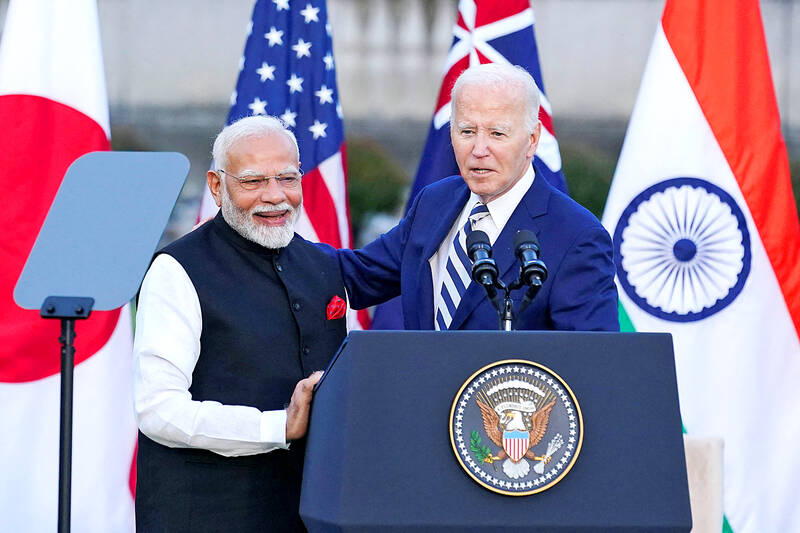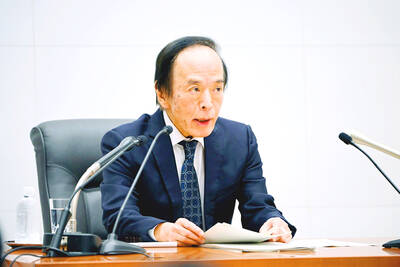The US and India reached an agreement to work together on setting up a semiconductor fabrication plant in the South Asian nation, giving a boost to Indian Prime Minister Narendra Modi’s efforts to bolster manufacturing in the country.
The proposed plant would make infrared, gallium nitride and silicon carbide semiconductors, according to a White House readout that followed a meeting between US President Joe Biden and Modi in Delaware on Saturday.
The setting up of the facility would be enabled by support from the India Semiconductor Mission and a “strategic technology partnership between Bharat Semi, 3rdiTech Inc and the US Space Force,” the readout said.

Photo: Reuters
India’s strategic geopolitical position in Asia has provided a fresh spotlight on the country and the opportunities it can afford in the field of technology.
Modi in the past decade has repeatedly said he would position India as an alternative to China, and it has already begun to pull away some of its manufacturing from Apple Inc and Samsung Electronics Co.
India is attempting to develop the entire chip value chain, Indian Minister of Railways, Information and Broadcasting, Electronics and Information Technology Ashwini Vaishnaw said earlier this month.
It aims to increase its electronics sector to US$500 billion by the end of the decade.
The countries also announced efforts to fund projects “catalyzing India’s domestic clean energy supply chain build out” for about US$1 billion through the International Bank for Reconstruction and Development.
Modi is visiting the US for the annual Quad Leaders’ Summit and in the three-day trip, he is holding bilateral meetings with its leaders, addressing the UN General Assembly and meeting with the Indian diaspora and US technology industry executives.
Modi on Sunday met with Alphabet Inc’s Google CEO Sundar Pichai, Nvidia Corp CEO Jensen Huang (黃仁勳), and Eli Lilly and Co CEO David Ricks among others. He also addressed an Indian diaspora event in Long Island, New York.
The next Quad meeting is scheduled to be held in India next year.

Taiwan Semiconductor Manufacturing Co (TSMC, 台積電) last week recorded an increase in the number of shareholders to the highest in almost eight months, despite its share price falling 3.38 percent from the previous week, Taiwan Stock Exchange data released on Saturday showed. As of Friday, TSMC had 1.88 million shareholders, the most since the week of April 25 and an increase of 31,870 from the previous week, the data showed. The number of shareholders jumped despite a drop of NT$50 (US$1.59), or 3.38 percent, in TSMC’s share price from a week earlier to NT$1,430, as investors took profits from their earlier gains

In a high-security Shenzhen laboratory, Chinese scientists have built what Washington has spent years trying to prevent: a prototype of a machine capable of producing the cutting-edge semiconductor chips that power artificial intelligence (AI), smartphones and weapons central to Western military dominance, Reuters has learned. Completed early this year and undergoing testing, the prototype fills nearly an entire factory floor. It was built by a team of former engineers from Dutch semiconductor giant ASML who reverse-engineered the company’s extreme ultraviolet lithography (EUV) machines, according to two people with knowledge of the project. EUV machines sit at the heart of a technological Cold

TAIWAN VALUE CHAIN: Foxtron is to fully own Luxgen following the transaction and it plans to launch a new electric model, the Foxtron Bria, in Taiwan next year Yulon Motor Co (裕隆汽車) yesterday said that its board of directors approved the disposal of its electric vehicle (EV) unit, Luxgen Motor Co (納智捷汽車), to Foxtron Vehicle Technologies Co (鴻華先進) for NT$787.6 million (US$24.98 million). Foxtron, a half-half joint venture between Yulon affiliate Hua-Chuang Automobile Information Technical Center Co (華創車電) and Hon Hai Precision Industry Co (鴻海精密), expects to wrap up the deal in the first quarter of next year. Foxtron would fully own Luxgen following the transaction, including five car distributing companies, outlets and all employees. The deal is subject to the approval of the Fair Trade Commission, Foxtron said. “Foxtron will be

INFLATION CONSIDERATION: The BOJ governor said that it would ‘keep making appropriate decisions’ and would adjust depending on the economy and prices The Bank of Japan (BOJ) yesterday raised its benchmark interest rate to the highest in 30 years and said more increases are in the pipeline if conditions allow, in a sign of growing conviction that it can attain the stable inflation target it has pursued for more than a decade. Bank of Japan Governor Kazuo Ueda’s policy board increased the rate by 0.2 percentage points to 0.75 percent, in a unanimous decision, the bank said in a statement. The central bank cited the rising likelihood of its economic outlook being realized. The rate change was expected by all 50 economists surveyed by Bloomberg. The